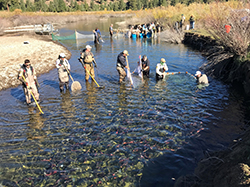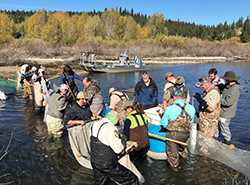Each October, conditions permitting, CDFW staff and volunteers from the California Inland Fisheries Foundation, Inc. and Kokanee Power descend on the Little Truckee River, just upstream from Stampede Reservoir near Truckee, and get to work on the annual Kokanee Egg Take.

CDFW staff and volunteers set a one-day record of 1.5 million eggs collected on the Little Truckee River earlier this month.

CDFW staff and volunteers use seine nets and electric fishing techniques to corral and capture adult Kokanee salmon.

Volunteers from the California Inland Fisheries Foundation, Inc. and Kokanee Power help CDFW personnel capture Kokanee salmon.
Each October, conditions permitting, CDFW staff and volunteers from the California Inland Fisheries Foundation, Inc. and Kokanee Power descend on the Little Truckee River, just upstream from Stampede Reservoir near Truckee, and get to work on the annual Kokanee Egg Take.
Using seine nets and electrofishing techniques to corral and capture adult Kokanee Salmon, staff and volunteers then collect eggs and milt (fish semen) add them together in specific ratios to complete the spawning process. The fertilized eggs are carried to an egg care station on the side of river where they are measured, enumerated, disinfected and finally placed in containers to be transferred to the San Joaquin Hatchery.
Staff at San Joaquin Hatchery incubate, hatch and care for the early-life stages of the resulting baby salmon. Some fertilized eggs are shipped to other CFDW hatcheries for hatching and rearing. Resulting fingerling fish are stocked to several approved waters in the state to provide recreational angling opportunities.
“By all accounts, this year set the one-day egg take record of 1.5 million eggs,” said Roger Bloom, CDFW’s Inland Fisheries Program Manager. “This was a collective effort from our scientists, hatchery staff and stakeholders that culminated into actions in support of fisheries across the state. Given the magnitude of eggs taken on that record day, it took a non-stop effort of over 23 straight hours to get the job done, which highlights the dedication and resolve CDFW personnel have -- especially the hatchery staff who now will care for these eggs that will eventually grow to be little salmon!”
Kokanee Salmon were introduced into California waters to provide diverse recreational angling opportunities for anglers and have become an extremely popular sport fish. They are typically smaller than the landlocked Chinook Salmon, with an average size of about 12 inches. This summer, CDFW will release the Kokanee Salmon fingerlings that emerge from this collection effort into lakes and reservoirs throughout the state.
The landlocked version of the Sockeye Salmon, the Kokanee (pronounced coke-a-nee) Salmon spends its entire life in fresh water. Instead of migrating to the ocean, adult Kokanee Salmon inhabit large lakes before returning to their natal streams or gravelly shorelines to spawn. Like all Pacific salmon, Kokanee die after spawning, the whole life cycle taking from two to four years.
CDFW Photos. Top Photo: Volunteer holds a Kokanee salmon during work on the Little Truckee River.